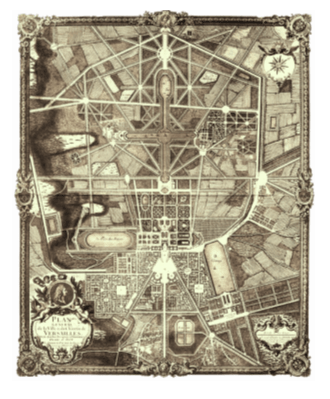Versailles, one of the grandest and most opulent palaces in Europe, was constructed in the marshy Galie Valley. The site was chosen for many reasons, few of them practical, but for over 150 years the palace drew energy and water from the surrounding landscape , whilst the Sun King, Louis XIV, basked in the glory of his creation
If it hadn’t been for Louis XIII’s passion for the hunt and his indifferent relationship with his wife and her female entourage, one of the greatest palaces in the world might never have been built. The Galie Valley, in which Versailles now stands, was uneven, waterlogged in places and consisted of some poor areas of forest, heath land and pasture. What it did have was a plentiful supply of game, which drew Louis XIII to the area from the Royal Palace of Saint-Germain-en-Laye.
In 1623 he had a hunting lodge built on the site of an old windmill. Wind and water played an important part in the establishment of Versailles. Strong winds race through the valley, which has an East/West orientation and acts as a wind tunnel. The wind and the windmills of the valley – which, during the reign of his son Louis XIV, were used to pump water to the endless fountains and ponds at Versailles – did not put Louis XIII off the location. He already had plans to install a mistress in the hunting lodge and only sanctioned two visits from his then wife, who appears to have been whisked around the latest building additions and then immediately sent back to Saint-Germain-en-Laye.
The real expansion of the Versailles complex began in 1669 in the reign of Louis XIV, who commissioned Louis Le Vau to create a great palace that would provide a suitable setting for the ceremonies of the royal court. The palace and garden followed the Italian tradition, by taking inspiration from classic mythology.
SPONSORED
Like others before him Louis XIV took the sun as his emblem, becoming known as the Sun King. He filled the garden with images of himself in the guise of Apollo, giver of light, and ensured that many of the rooms had classical, mythological or astrological themes.
The water features provide a great insight into the scale of the project. The quantity of water on site could not supply all the fountains and ponds built by Louis XIV, which at their peak used a staggering 220 gallons of water per second.
Water was drawn from afar using aqueducts up to 69 miles long (tens of thousands of labourers died during these construction projects), which was then stored in huge reservoirs, some underground.
Though initially the ground was water-logged and foul smelling, which would suggest a bad site full of sha ch’i, or stagnant ch’i, the water was drained and put to good use, circulating slowly through the gardens and improving the energy of the area.

The Palace of Versailles, for more than 100 years (1682-1790) the official residence of the Kings of France, is located at 48° 48’ latitude and 22° 17.5’ longitude. The so-called ‘Versailles meridian’ passes directly through the Château, and the palace’s position in the universe was plotted exactly by Louis’ architects. For Louis, it was the centre of the universe, a fitting place for a Sun King. Knowing where he was and what he was doing at any given moment was a major preoccupation for Louis XIV.
The founding of Versailles corresponds with hexagram 31, whose astrological commentary indicates ‘great nourishment…where the water, when used, will stimulate growth and development’. The completion of the building corresponds to hexagram 34, which is interpreted as ‘the power of the great‘.e astrological commentary for this hexagram states that ‘Many will demonstrate their power as persistence in attaining objectives, regardless of whether the objective is right or wrong’.
Three roads converge in front of the palace gates in what was described as a crow’s foot. These bring strong ch’i onto the entrance of the Palace.
In a small building they might act as ‘secret arrows’, but on the scale of Versailles they simply draw in the ch’i. The forecourt is wide and increased in size by the deliberate setting back of the actual entrance, giving a maximum ‘bright hall effect’ which is excellent at accumulating beneficial ch’i.
At first Louis XIV moved the centre of government simply to be out of Paris, but as time progressed he realised that by doing so he was drawing the political influence of the French Parliament and the power of the French nobility towards himself.
By manipulating the sycophantic royal court and demanding the presence of the French nobility at Versailles he was able to consolidate the levers of power in his own hands and, most importantly, prevent his nobles fomenting rebellion from the safety of their own château. The palace continued to grow, steadily becoming more lavish and increasingly ornate. Eventually, in 1789 during Louis XVI’s reign, the French people stormed
 |  |  |
![]()
SPONSORED






